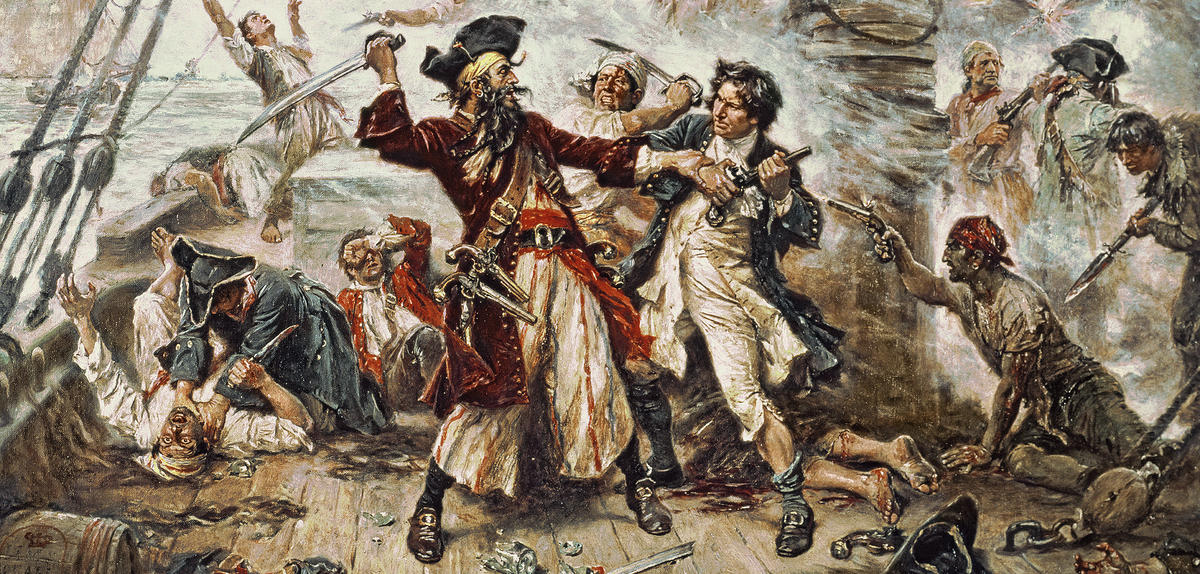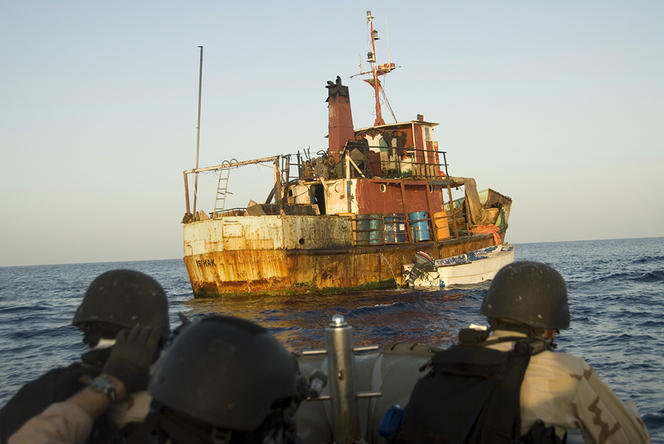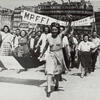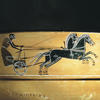You are here
The Truth about Pirates

How long have there been pirates in the world?
Philippe Hrodej:1 Pirates have existed ever since sailing was invented. Piracy is nothing more than robbery at sea, in other words attacking merchant ships with no distinction of nationality—although some pirates did have qualms about robbing their own countrymen… In the Mediterranean, small, fast sailboat galleys were already stalking merchant ships in ancient times, and the Romans were constantly trying to chase them down. Piracy has long been endemic in certain regions, like the Cyclades in the Aegean Sea, the Adriatic and the Black Sea. Pirates were after anything and everything that could be traded for cash: the ship itself, its cargo, the arms on board, and even the crew, who could be pressed into service or held for ransom. In actual fact, any vessel that the pirates saw as being weaker was liable to become their prey.

What makes a pirate different from a privateer?
Gilbert Buti: A pirate works for himself and doesn’t share his loot with anyone except for his own crew, whereas a privateer operates primarily during wartime, serving the interests of his country by attacking its enemies, with the authorization of his government. He is issued a 'letter of marque' or 'commission' defining the duration of his mission—usually two to four months—and the enemy nations that he is allowed to attack. Every time a privateer captured a ship, he had to sail it to a friendly port, where an official inventory would be made of the cargo, with the captains of both ships plus the crewmembers giving testimony about the conditions of capture. In France, these documents were sent to the Conseil des Prises (maritime prize court), which would decide whether it was a lawful or an unlawful seizure of the assets of an allied or neutral state. The process could take several weeks. In the case of a lawful seizure, the ship and its cargo would be auctioned and the proceeds of the sales divided among the king, who took 10%, funds for seamen’s widows and various other allotments, and lastly the crew and owner of the privateering ship, who shared the remaining 80%. I should add that pirates and privateers did not enjoy the same legal status if they were caught. Pirates were usually executed after a hasty trial, while privateers were considered prisoners of war, who were held and possibly exchanged for other POWs.
You said that piracy is as old as sailing itself. What about privateering?
G.B.: The practice began to be institutionalized around the 15th century. In the Middle Ages there was a 'right of reprisal' authorizing ships that had been plundered to attack a vessel of the same nationality as their assailant. By the 16th century privateering was an officially approved practice. We all know the name of Francis Drake, a privateer who was instrumental in the reign of Elizabeth I, Queen of England, by bringing in sufficient wealth for her not to have to call upon Parliament to levy taxes. She later made him a knight in gratitude for his services. But the real golden age of privateers was the 17th century and the reign of Louis XIV. Three nations were especially active: France, England and the United Provinces, or what is now the Netherlands. For a national government, commissioning privateers was often a way to bolster a relatively weak navy.
After the battle of La Hogue in 1692, which saw the Dutch and English defeat Louis XIV’s fleet, France no longer had the means to finance ships for naval warfare and moved towards more intensive commerce raiding, which offered the dual advantage of weakening the enemy while bringing in additional state revenue. There was also the 'joint commissioning' of privateer ships, by which the government leased or lent its military vessels to a private ship owner. One good example is René Duguay-Trouin, a famous privateer from Saint-Malo, who first served on merchant ships fitted out as raiders, before becoming an officer in the royal navy. Of the other well-known French corsairs, Jean Bart did the same, but Surcouf never wanted to join the king’s navy.

Is the distinction between pirates and privateers really that clear-cut? Some privateer captains had a reputation of being ruthless…
P.H.: Let’s just say that within every privateer there slept a pirate… Sometimes privateers 'forgot' to follow procedures. For example, on their way back to Saint-Malo, the French privateers would anchor at the nearby Cap Fréhel and hide part of their captured cargo before officially returning to port. Certain practices on the high seas also stretched the limits between privateering and piracy. French corsairs had a custom, called pluntrage, whereby each crew member seized the valuables of his 'alter ego' from the captured ship: the pilot would take the enemy pilot’s bell, the captain would keep the other captain’s money and sword, etc. But what began as a tolerated habit often led to excesses.
It all becomes more complicated in the case of the freebooters…
P.H.: Freebooting was originally defined by a geographic zone. It emerged in the 16th century with the Spanish colonization of America, and mainly targeted Spanish galleons returning from the New World laden with gold and silver, as well as tobacco, sugar cane, etc. At first, French and English freebooters sailed between Europe and America to capture these riches. The establishment of French and English colonies in the West Indies, starting in the 17th century, gave rise to the famous 'pirates of the Caribbean'—sailors who chose those islands as their rear base. Tortuga, an island off the coast of Hispaniola (now Haiti) was popular withFrench freebooters, while the English favored Port Royal in Jamaica.
Were the freebooters pirates or privateers?
P.H.: With the freebooters, it was a case of 'privateer-piracy.' They were supposed to operate like the privateers, but found themselves thousands of kilometers from the seat of authority, often with difficult living conditions… While they did indeed have commissions from the local governors, their takings were divided in a more “personalized” way than they were in Europe—there was no such thing as exhaustive official inventories! In fact, the freebooters didn’t always bring their haul back to their home port… Versailles and London turned a blind eye because anything that weakened Spain, their sworn enemy, helped their cause. Initially, the presence of freebooters like François l’Olonnais and Henry Morgan helped French and British colonies to develop and defend themselves. But there came a time when the buccaneers were more of a liability than an asset. The authorities realized that sugar and indigo production in the West Indies needed peace in order to thrive, and that it was more profitable to trade with the Spanish—and in particular sell them slaves brought over from Africa, where Spain had no presence—than seize their goods by force. Freebooting was outlawed, but of course not all of the raiders were ready to retire… Some became pirates and moved to other parts of the world: the Pacific and the South Seas, the Indian Ocean or the Red Sea, where they were very active in the decade from 1715 to 1725.

Pirates and privateers are associated with a whole range of imagery: the eye patch, the parrot, and especially scenes of boarding and spectacular, bloody battles. Does this correspond to reality?
P.H.: This image was invented in the 18th and 19th centuries by writers including Daniel Defoe and Robert Louis Stevenson, and immortalized by Hollywood. In reality, boarding another vessel was always the exception, because no one wanted to damage their ship or lose men in an attack. Pirates and privateers were always careful to attack vessels that were slower and more vulnerable than theirs, and tried to intimidate them in various ways: firing warning shots or flying flags that were supposed to instill terror. For a long time pirates flew a red flag as a signal meaning, 'Surrender or we will show no mercy and blood will flow.'
Some pirates were presented as seafaring 'Robin Hoods' or freedom-loving autonomous spirits. That was the basis of the myth surrounding Libertalia, an anarchist colony purportedly built by pirates in Madagascar. But the real-life pirates and privateers were more like business executives managing their small operations as best they could!
When did the privateers disappear?
G.B.: In 1856, the Treaty of Paris put an end to commerce raiding at sea. It was no longer really profitable, especially since the old traditional enemies had stopped fighting one another. This agreement also brought about maritime specialization, with a clear separation between merchant and military fleets. Waging war with merchant ships was a thing of the past. This period also saw the launch of the first modern warships, powered by steam engines. There were, however, some acts of quasi-privateering committed during the American Civil War, and some historians find similarities in the attacks by German U-boats on allied merchant vessels during World War I—with one blatant difference: the privateers of the 17th and 18th centuries did not seek to destroy enemy ships, but merely to capture them.
On the other hand, piracy has not disappeared from the world’s seas and oceans…
G.B.: A few years ago there was a surge of piracy along the Somalian coast, where ships pass after crossing the Suez Canal, around the Persian Gulf and in Southeast Asia, at the mouth of the Strait of Malacca. For these pirates, many of whom were fishermen reduced to poverty by the pollution of their fishing zones, the preferred targets were container ships, cargo vessels and pleasure craft. In the past two or three years, the attacks along the Somalian coast, usually involving ransom demands and the seizure of electronic equipment, have been less frequent as a result of surveillance patrols set up by the ship owners. On the other hand, acts of piracy are on the rise in the Gulf of Guinea, off the coast of West Africa. As with Somalia, these crimes are often an extension at sea of the crises affecting the coastal regions. In this case, the main targets are oil platforms and tankers. The captured petroleum is resold directly through organized networks in the area. Certain local authorities are suspected of collusion, seeing piracy as an economic 'safety valve' to help them control local populations suffering from severe poverty.
- 1. Gilbert Buti and Philippe Hrodej (dir.), "Histoire des pirates et corsaires, de l'Antiquité à nos jours," (Paris: CNRS éditions, 2016). French only.

















